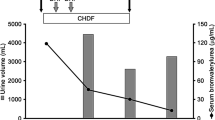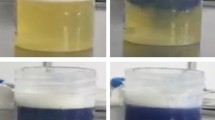Abstract
A case of severe sodium chlorate poisoning was observed within 5 h after suicidal ingestion of 150–200 g of the herbicide. Methaemoglobinaemia was the early symptom of the intoxication. Treatment with methylene blue and ascorbic acid could not prevent a massive haemolysis with disseminated intravascular coagulation. Hypercoagulation and hyperfibrinolysis could be treated successfully with exchange transfusions, heparin and fresh plasma. During the first hours, 70 mmol chlorate were excreted before complete renal failure occurred which required haemodialysis for several weeks. Clinical observations and in vitro experiments provide evidence that methylene blue is effective only in the very early stages of chlorate poisoning. Consequently, the following treatment is suggested: gastric lavage, exchange transfusion, bicarbonate infusion, haemodialysis, anticoagulation with heparin and substitution of clotting factors if necessary.
Similar content being viewed by others

References
Bing RJ (1943) Etiology of renal failure following crush injuries. Proc Soc Exp Biol Med 53: 29–30
Bing RJ (1944) The effect of hemoglobin and related pigments on renal functions of the normal and acidotic dog. Bull Johns Hopkins Hosp 74: 161–176
Bloxham CA, Wright N, Hoult JG (1979) Self-poisoning by sodium chlorate — some unusual features. Clin Toxicol 15: 185–188
Bode C, Goebell H, Stähler E (1968) Zur Eliminierung von Trübungsfehlern bei der Eiweißbestimmung mit der Biuretmethode. J Clin Chem Clin Biochem 6: 418–422
Bradlow BA (1961) Liberation of material with platelet-like coagulant properties from intact red cells and particularly from reticulocytes. Br J Haematol 7: 476–495
Brandslund I, Hyltoft Petersen P, Strunge P, Hole P, Worth V (1980) Haemolytic uraemic syndrome and accumulation of haemoglobin-haptoglobin complexes in plasma in serum sickness caused by penicillin drugs. Haemostasis 9: 193–203
Clarkson AR, Lawrence JR, Meadows R, Seymour AE (1970) The haemolytic-uraemic syndrome in adults. Q J Med 39: 227–239
Cochrane WJ, Smith RP (1940) A fatal case of accidental poisoning by chlorate of potassium: with a review of the literature. Can Med Assoc J 43: 23–26
Egbring R, Havemann K (1978) Possible role of polymorphonuclear granulocyte proteases in blood coagulation. In: Havemann K, Janoff A (eds) Neutral proteases of human polymorphonuclear leukocytes. Urban u. Schwarzenberg, Baltimore München, pp 442–455
Folin O, Wu H (1919) A system of blood analysis. J Biol Chem 38: 81–110
Gordon S, Brown JAH (1947) Potassium chlorate poisoning. Lancet 2: 503–504
Hayem G (1886) Nouvelles recherches sur les substances toxiques ou médicamenteuses qui transforment l'hémoglobine en méthémoglobine. CR Acad Sci [D] (Paris) 102: 698–700
Klendshoj NC, Burke WJ, Anthone R, Anthone S (1962) Chlorate poisoning. JAMA 180: 1133–1135
Knight RK, Trounce JR, Cameron JS (1967) Suicidal chlorate poisoning treated with peritoneal dialysis. Br Med J 3: 601–602
Künzer W, Haberhausen A (1963) Fibrinolytic activity of human erythrocytes. Nature 198: 396–397
Lee DBN, Brown DL, Baker LRJ, Littlejohns DW, Robert PD (1970) Haematological complications of chlorate poisoning. Br Med J 2: 31–32
Marchand F (1887) Über die giftige Wirkung der chlorsauren Salze. Naunyn-Schmiedebergs Arch Exp Path Pharmak 22: 201–233
Mayer RL (1922) Der Mechanismus der Chloratwirkung. Naunyn-Schmiedebergs Arch Exp Path Pharmak 95: 351–377
Mengele K, Schwarzmeier J, Schmidt P, Moser K (1969) Klinik und Untersuchungen des Erythrozytenstoffwechsels bei Vergiftungen mit Natriumchlorat. Int J Clin Pharmacol 2: 120–125
Mering J von (1885) Das chlorsaure Kali, seine physiologischen, toxischen und therapeutischen Wirkungen. Verlag August Hirschfeld, Berlin
O'Grady J, Jarecsni E (1971) Sodium chlorate poisoning. Br J Clin Pract 25: 38–39
Oliver J, MacDowell M, Tracy A (1951) The pathogenesis of acute renal failure associated with traumatic and toxic injury. Renal ischemia, nephrotoxic damage and the ischemuric episode. J Clin Invest 30: 1307–1351
Pugh DM, Sheahan BJ (1971) The quantitative estimation of the chlorate ion in plasma and urine. Arch Toxicol 28: 63–67
Stavrou A, Butcher R, Sakula A (1978) Accidental self-poisoning by sodium chlorate weed-killer. Practitioner 221: 397–399
Stokvis BJ (1886) Die Ursache der giftigen Wirkung der chlorsauren Salze. Naunyn-Schmiedebergs Arch Exp Path Pharmak 21: 169–218
Author information
Authors and Affiliations
Additional information
Dedicated to Prof. Gustav Adolf Martini on occasion of his sixty-fifth birthday
A preliminary report has been given at the Spring Meeting of the German Pharmacological Society, Mainz, March 1981
Rights and permissions
About this article
Cite this article
Steffen, C., Seitz, R. Severe chlorate poisoning: Report of a case. Arch Toxicol 48, 281–288 (1981). https://doi.org/10.1007/BF00319656
Received:
Issue Date:
DOI: https://doi.org/10.1007/BF00319656



